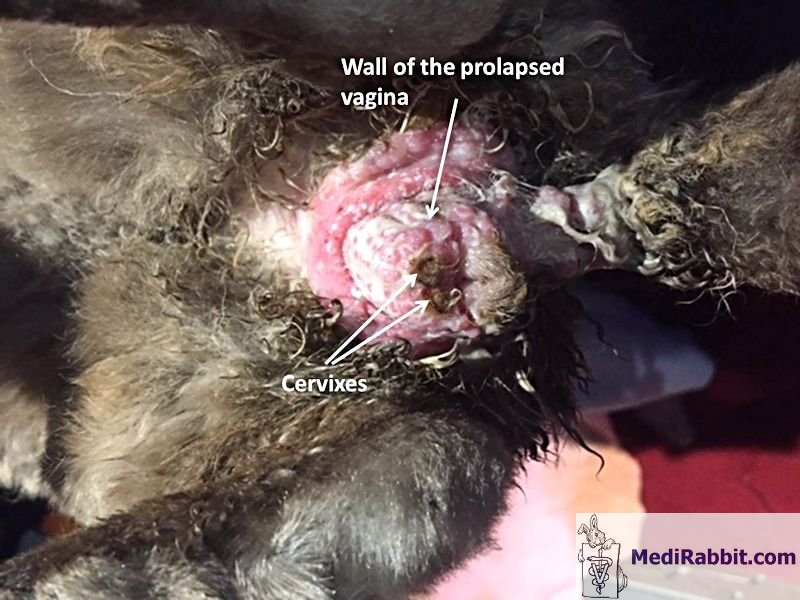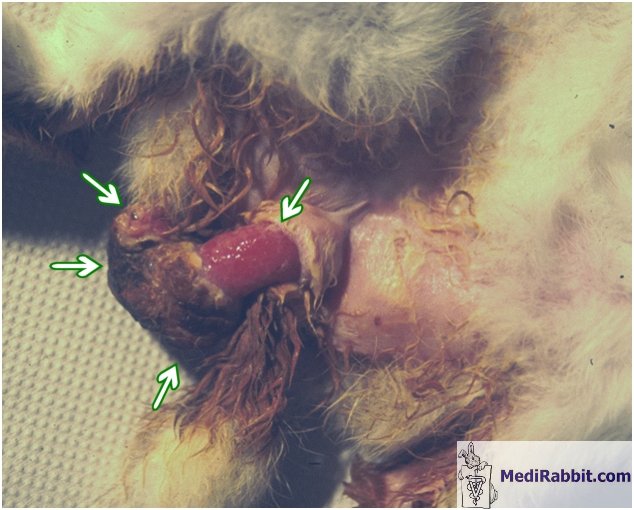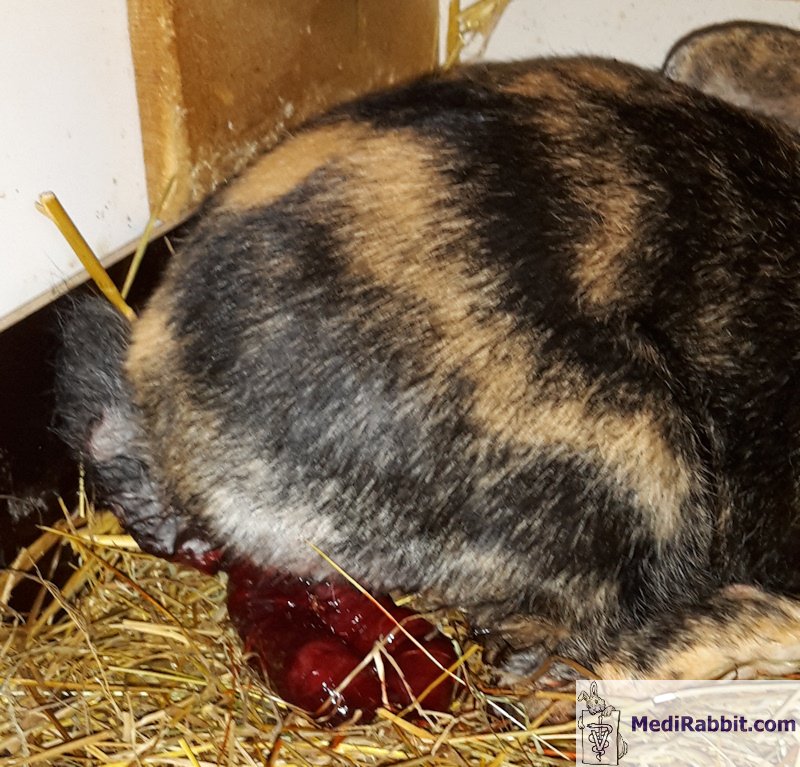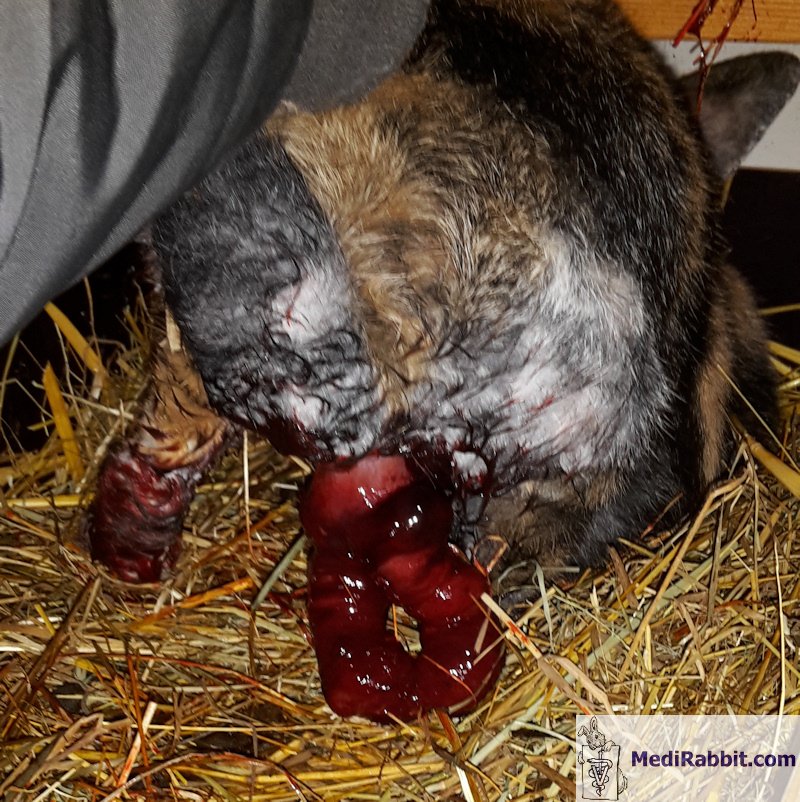Vaginal
prolapse in the rabbit
Esther van Praag, Ph.D.
|
MediRabbit.com is
funded solely by the generosity of donors. Every
donation, no matter what the size, is appreciated and will aid in the
continuing research of medical care and health of rabbits. Thank you |
Warning: this file
contains pictures that may be distressing for people.
|
Vaginal prolapse is rarely observed in
female rabbit. It may be caused by over-expanded blood sinuses located
beneath the mucous membrane of the vaginal wall and the vestibulum
vaginae - the space region containing the
openings of the vagina, urethra, and excretory ducts of the greater
vestibular glands. The prolapse often starts from the proximal circular part
of the vaginal vault that is located distal to the urethral opening. The
dorsal portion of the vaginal vault appears much more distended than the
ventral part. It can be accompanied by some degree of vaginal wall prolapse.
The protruding mass can be filled with blood clots.
Charlene McGrath Thumper, a female rabbit that developed a
prolapse of the vagina after being spayed. The organ was cleaned and sutured
in place. The rabbit survived the surgical procedure and recovered fine.
The
causes that lead to a prolapse in female rabbits are not well understood. It
may relate to: -
A trauma sustained during a difficult or long
parturition (dystocia); -
The presence of polyps in the urinary tract; -
A painful discharge of urine (straining) caused by a
bacterial infection and/or the presence of a stone in the bladder or the
kidney; -
An increased mating activity with a male rabbit; -
Ovariohysterectomy; -
Presence of
mycotoxins in food. Mechanical causes include retained fetal
membranes in the uterus, or lack of movement. A congenital factor could be
involved.
Zahi Aizenberg Vaginal prolapse
with a mass of brown and pink hemorrhagic tissue (arrows) protruding from the
vulvar opening in a female rabbit. Prognosis depends on the extent of the
prolapse, the damage of the organ, the amount of blood lost as well as the
period of time between the prolapse and the repair. It is generally poor and
the doe dies within the next hours. Differential diagnosis
The condition
should be differentiated from: • Natural
abortion; • Trauma due to
the excessive mounting behavoir by a male rabbit; • Constipation;
• Hernia; • Rectal
prolapse; • The presence
of kidney or bladder calculi; • Spay; • Infection of
the urinary tract, urine scald caused by incontinence.
Luc Page
Prolapse of the uterus with fetus yet unborn, 24
hours before the expected date of birth. The doe died but her fetuses could
be saved. Another doe adopted them and has since cared for them and fed them. Clinical signs
The
female rabbit is often found in a state of severe shock. She is depressed,
recumbent, with an increased respiratory rate. This can be accompanied by
constipation, difficult movement, difficult urination or incontinence, and
bleeding. Typically, a red edematous mass sticks out of the vulva. The risks
of shock, bleeding and thromboembolism raises when treatment is delayed.
Hematocrit is 8 to 15%. In a
rare case, eversion of the bladder has been observed in does that gave birth.
A mass was found to protrude from the vagina. The rabbit strained to urinate.
Treatment
The rabbit is
often found in a state of severe hypovolemic shock, due to blood loss, with
pale, cyanotic mucous membranes and ears. The extremities of the limbs feel
cold. It can be accompanied by hemorrhaging and/or blood loss. The treatment
depends on the state of the organ. If the tissue is not damaged or necrotic,
the prolapsed organ can be cleaned and moved back in place by gentle digital
pressure. It is important not to block the urethra during the procedure.
Sedation and local anesthesia help in the reduction. Recurrence is possible. The treatment
of choice appears, however, removal of the affected tissue and
ovariohysterectomy. Administration
of pain medication is recommended, in order to reduce discomfort after the
reduction (e.g. flunixin, meloxicam). When a
bacterial infection is present, a systemic antibiotic treatment must be
started. Acknowledgement
Many thanks are due to Zahi Aizenberg, DVM, (the
Hebrew University of Jerusalem, Israel), to Charlene McGrath (Canada), to Luc
Page (Switzerland) and Michel Gruaz (Switzerland)
for their pictures and their permission to use them in MediRabbit.
Further Information
Greenacre CB, Allen
SW, Ritchie BW. Urinary bladder eversion in rabbit does. Compendium on
Continuing Education for the Practicing Veterinarian, 1999, 21, 6,524-8. Meredith A, Flecknell P.
BSAVA Manual of Rabbit Medicine and Surgery Second Edition BSAVA, 1 Telford
Way, Quedgeley, Gloucester, GL2 2AB, UK. 2006 Quesenberry KE, Carpenter JW. Ferrets, Rabbits and
Rodents - Clinical Medicine and Surgery. Second Edition. WB Saunders,
Philadelphia, Pennsylvania, USA. 2004. Sood P, Nanda AS,
Srivastava AK. Rupture of vagina in an Angora rabbit. Indian J Vet Surg 1998; 19 (126),
50. Van Herck H, Hesp AP, Versluis A, Zwart P,
Van Zutphen LF. Prolapsus vaginae in the IIIVO/JU rabbit. Lab Anim. 1989;
23(4):333-6. |
e-mail: info@medirabbit.com








